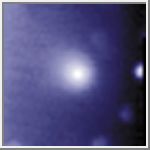|
COMETS EARTH JUPITER KUIPER BELT MARS MERCURY METEORITES NEPTUNE OORT CLOUD PLUTO SATURN SOLAR SYSTEM SPACE SUN URANUS VENUS ORDER PRINTS
PHOTO CATEGORIES SCIENCEVIEWS AMERICAN INDIAN AMPHIBIANS BIRDS BUGS FINE ART FOSSILS THE ISLANDS HISTORICAL PHOTOS MAMMALS OTHER PARKS PLANTS RELIGIOUS REPTILES SCIENCEVIEWS PRINTS
|
Related Document
Download Options
Hydrogen cloud around Comet LINEAR as observed by the SWAN instrument, almost a month before the comet disintegrated. The field of view is 21 million kilometres wide.
Caption: As water evaporates from a comet, it is split into its components of oxygen and hydrogen by radiation from the Sun. The hydrogen atoms "glow" in yet more radiation originating from our star, and this glow can be observed by the SWAN instrument on board SOHO. Primarily designed to study the interaction of the solar wind with the interstellar breeze of hydrogen, the instrument dubbed Solar Wind Anisotropies scans the sky is also a unique observer of comets. Similar observations are impossible from the ground, due to the absorption in the atmosphere, glare from the Sun during daytime, and a hydrogen cloud surrounding the Earth itself. The total amount of water vapour observed by SWAN from 25 May to 12 August 2000 is estimated at 3.3 million tonnes. Only about 1% of this was left on 6 August, when one observation by the Hubble Space Telescope of the dying comet's fragments gave an estimate of the total volume of the fragments. Combining the two numbers give a remarkably low value for the density - about 15 kilograms per cubic meters, compared with 917 kg/m3 for familiar non-porous ice. Even allowing for an equal amount of dust grains, 30 kg/m3 is far less than the 500 kg/m3 often assumed by comet scientists. For this reason, the estimated water ice content is expected to raise some controversy. Assuming a homogenous composition of the whole comet, the nucleus had a diameter of about 750 metres at the beginning of SWAN's observation series. |
